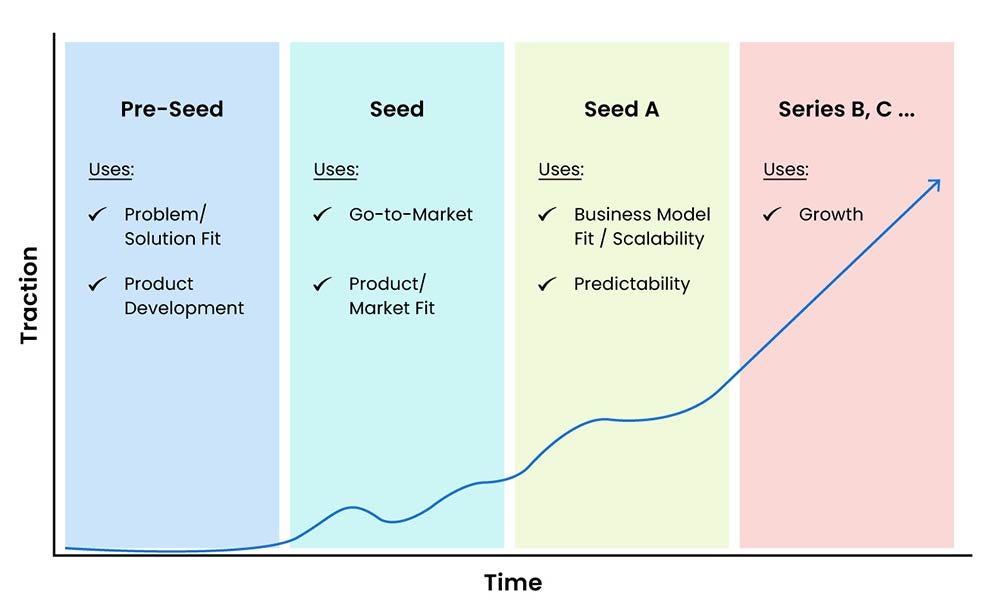How to go from Seed to Series A to Series B funding

🌈 Abstract
The article discusses the journey from Seed to Series A to Series B funding for startups, with a focus on the key factors and strategies involved in each stage.
🙋 Q&A
[01] Seed to Series A to Series B
1. What are the key differences between the Seed to Series A and Series A to Series B stages?
- Seed to Series A is about achieving product-market fit and defining a product that solves customer problems.
- Series A to Series B is about solidifying the go-to-market (GTM) strategy, monetizing it well, and continuing to grow the product.
- The Series B goalpost is typically $10M in Annual Recurring Revenue (ARR) for most companies.
2. What is the most important pattern the author observed across the startup experiences?
- The most important pattern was defining a clear GTM motion and scaling it. The author emphasizes the importance of contract sizes and the ability to sell more contracts in the desired sizes and ranges.
3. How does the focus on product vs. GTM differ between the stages?
- From Seed to Series A, product and sales go hand-in-hand, as the focus is on reaching feature parity or creating something better to help with selling.
- From Series A to Series B, GTM becomes more important than product, as the focus shifts to solidifying the GTM strategy and expanding contract sizes.
4. What are the key metrics and goals for each stage?
- Seed to Series A: Reaching $1-2M in revenue, with a mix of contract sizes (e.g., $10k, $50k, $100k).
- Series A to Series B: Focusing on selling larger contracts to new customers and selling more to existing customers, with a goal of reaching $10M ARR.
[02] Importance of GTM and Contract Sizes
1. Why is GTM more important than product from Series A to Series B?
- By the time a company reaches Series A, the foundation of the product has been developed enough to get to $10M ARR. The GTM strategy and execution become the key focus to drive growth from $1M to $10M ARR.
2. How do contract sizes impact the path to $10M ARR?
- Expanding contract sizes is crucial, as selling more smaller contracts ($10k) requires a much higher volume compared to selling fewer larger contracts ($100k) to reach the $10M ARR goal.
3. What are the two main ways to expand contract sizes?
- Selling upmarket to larger customers.
- Selling more to existing customers through upselling and cross-selling.
4. What is the role of customer success in contract size expansion?
- Having a dedicated customer success function (either formally or informally) is important to maintain customer relationships, understand their problems, and facilitate upselling and cross-selling.
[03] Outbound vs. Inbound Sales
1. Why does the author emphasize the importance of outbound sales over inbound?
- Outbound sales, in terms of quality, speed, scale, and consistency, are crucial, as inbound and virality are incredibly difficult to achieve.
2. What are the key elements of an effective outbound sales strategy?
- Focus on the volume of outbound, the quality of outbound/inbound, the speed of execution, learnings from each iteration, and the consistency of product development and GTM.
3. How does the author suggest balancing outbound and inbound sales efforts?
- If inbound and virality are not working, focus on mastering outbound and teaching the team to execute it effectively. Quality outbound can then lead to better inbound opportunities.
[04] Long-term Considerations
1. What are the long-term strategies the author suggests beyond the short-term revenue goals?
- Planting the seeds for long-term growth, such as building an SEO plan, developing organic acquisition strategies, and building great products and long-term partnerships.
2. How does the author suggest maintaining a culture of experimentation and innovation?
- Embracing a culture where employees are encouraged to take risks and innovate, even if some experiments may fail. This is the difference between a company that reaches Series B and one that doesn't.